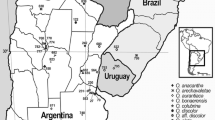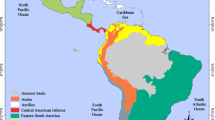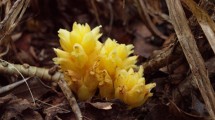Abstract
Within the genus Phragmites (Poaceae), the species P. australis (the common reed) is virtually cosmopolitan, and shows considerable variation in ploidy level and morphology. Genetic variation in Phragmites was studied using AFLPs, and analysed with parsimony and distance methods. Groups of P. australis strongly supported in the analyses include one that comprises all South American clones, a distinct group from the US Gulf Coast, and a group of E. Asian and Australian octoploids. Among the other species, the paleotropical P. vallatoria is supported as monophyletic and most closely related to the paraphyletic P. mauritianus and to the Gulf Coast and S. American groups. The E. Asian species P. japonicus is closely related to a group of P. australis clones mostly from central North America. Tetraploidy predominates in the genus, and optimisation of chromosome numbers onto the phylogeny shows that higher ploidy levels have evolved many times.
Similar content being viewed by others
References
S. Björk (1967) ArticleTitleEcologic investigations of Phragmites communis. Studies in theoretic and applied limnology Folia Limnologica Scandinavica 14 1–248
H. Brix (1999) ArticleTitleGenetic diversity, ecophysiology and growth dynamics of reed (Phragmites australis) Aquat. Bot. 64 179–184 Occurrence Handle10.1016/S0304-3770(99)00050-9
H. Brix H. Cizkova (2001) ArticleTitleIntroduction: Phragmites-dominated wetlands, their functions and sustainable use Aquat. Bot. 69 87–88 Occurrence Handle10.1016/S0304-3770(01)00131-0
Catling P. M., Mitrow G., Black L., Carbyn S. (2004) Status of the alien race of common reed (Phragmites australis) in the Canadian maritime provinces. Botanical Electronic News 324. http://www.ou.edu/cas/botany-micro/ben/ben324.html.
H. Cizkova H. Brix T. Herben (2000) ArticleTitleEcology of Phragmites populations in the changing landscape Folia Geobot. 35 351
W. D. Clayton (1967) ArticleTitleStudies in Gramineae: XIV. Arundineae. (Phragmites Adans.) Kew Bull. 21 113–117
O. A. Clevering J. Lissner (1999) ArticleTitleTaxonomy, chromosome numbers, clonal diversity and population dynamics of Phragmites australis Aquat. Bot. 64 185–208 Occurrence Handle10.1016/S0304-3770(99)00059-5
Conert H. J. (1961) Die Systematik und Anatomie der Arundineae. Cramer, Frankfurt am Main.
H. E. Connor M. I. Dawson R. D. Keating L. S. Gill (1998) ArticleTitleChromosome number in Phragmites australis (Arundineae: Gramineae) in New Zealand New Zealand J. Bot. 36 465–469
J. I. Davis (1999) Monophyly, populations and species P. M. Hollingsworth R. M. Bateman A. J. Gornall (Eds) Molecular systematics and plant evolution Taylor and Francis London 139–170
C. Den Hartog J. Kvet H. Sukopp (1989) ArticleTitleReed: a common species in decline Aquat. Bot. 35 1–4 Occurrence Handle10.1016/0304-3770(89)90062-4
L. Desprès L. Gielly B. Redoutet P. Taberlet (2003) ArticleTitleUsing AFLP to resolve phylogenetic relationships in a morphologically diversified plant species complex when nuclear and chloroplast sequences fail to reveal variability Molec. Phylogenet. Evol. 27 185–196 Occurrence Handle12695084 Occurrence Handle10.1016/S1055-7903(02)00445-1
R. S. Dodd Z. Afzal-Rafii N. Kashani J. Budrick (2002) ArticleTitleLand barriers and open oceans: effects on gene diversity and population structure in Avicennia germinans L Molec. Ecol. 11 1327–1338 Occurrence Handle1:STN:280:DC%2BD38zps1Ghsw%3D%3D Occurrence Handle10.1046/j.1365-294X.2002.01525.x
D. Dykyjova Z. Pazourkova (1979) ArticleTitleA diploid form of Phragmites australis as a possible result of cytogenetical response to ecological stress Folia Geobot. Phytotax. 14 1–112
L. Excoffier P. E. Smouse J. M. Quattro (1992) ArticleTitleAnalysis of molecular variance inferred from metric distances among DNA haplotypes: application to human mitochondrial DNA restriction data Genetics 131 479–491 Occurrence Handle1644282 Occurrence Handle1:CAS:528:DyaK38XlsVCntro%3D
J. S. Farris V. A. Albert M. Källersjö D. Lipscomb A. G. Kluge (1996) ArticleTitleParsimony jackknifing outperforms neighbor-joining Cladistics 12 99–124 Occurrence Handle10.1111/j.1096-0031.1996.tb00196.x
R. Gorenflot (1976) ArticleTitleLe complexe polyploide du Phragmites australis (Cav.) Trin. ex Steud. (=P. communis Trin.) Bull. Soc. Bot. Fr., 123 261–271
R. Gorenflot (1986) ArticleTitleDegrés et niveaux de la variation du nombre chromosomique chez Phragmites australis (Cav.) Trin. ex Steud. Veröff. Geobot Inst. ETH, Stiftung Rübel, Zürich 87 53–65
R. Gorenflot J. M. Hubac M. Jay (1984) ArticleTitleLe complexe polyploide du Phragmites australis Cav (Trin) ex Steud. dans la région méditerranéenne Webbia 38 715–721
R. Gorenflot H. Tahiri P. Lavabre (1990) ArticleTitleAnomalies méiotiques de la microsporogenèse dans un complex polyploide: Phragmites australis (Cav.) Trin. ex Steud. Rev. Cytol. Biol. Véget. – Bot. 13 153–172
GPWG (Grass Phylogeny Working Group) (2001) Phylogeny and subfamilial classification of the grasses (Poaceae). Ann. Missouri Bot. Gard. 88: 373–457.
V. Grant (1981) Plant speciation, 2nd edn Columbia University Press New York
W. Greuter H. Scholz (1996) ArticleTitlePhragmites in Crete. Cenchrus frutescens and the nomenclature of the common reed (Gramineae) Taxon 45 521–523 Occurrence Handle10.2307/1224146
C. Hsiao S. W. L. Jacobs N. P. Barker N. J. Chatterton (1998) ArticleTitleA molecular phylogeny of the subfamily Arundinoideae (Poaceae) based on sequences of rDNA Austral. Syst. Bot. 11 41–52 Occurrence Handle10.1071/SB97001
J. Ishii Y. Kadono (2001) ArticleTitleClassification of two Phragmites species, P. australis and P. japonica, in the Lake Biwa - Yodo River System, Japan Acta Phytotax. Geobot. 51 187–201
J. P. Kardolus H. J. Eck ParticleVan R. G. den Berg ParticleVan (1998) ArticleTitleThe potential of AFLPs in biosystematics: a first application in Solanum taxonomy (Solanaceae) Pl. Syst. Evol. 210 87–103 Occurrence Handle10.1007/BF00984729
H. Koppitz (1999) ArticleTitleAnalysis of genetic diversity among selected populations of Phragmites australis world-wide Aquat. Bot. 64 209–211 Occurrence Handle10.1016/S0304-3770(99)00051-0
H. Kühl H. Koppitz H. Rolletschek J. Kohl (1999) ArticleTitleClone Specific differences in a phragmites australis stand: I. Morphology, genetics and site description Aquat. Bot. 64 235–246 Occurrence Handle10.1016/S0304-3770(99)00053-4
Legendre P., Vaudor A. (1991) The R-package: Multidimensional analysis, spatial analysis. Département des Sciences Biologiques, Université de Montréal.
N. A. Mantel (1967) ArticleTitleThe detection of disease clustering and a generalized regression approach Cancer Res. 27 209–220 Occurrence Handle6018555 Occurrence Handle1:STN:280:CCiD1MzgsVY%3D
S. Mathews R. C. Tsai E. A. Kellogg (2000) ArticleTitlePhylogenetic structure in the grass family (Poaceae): evidence from the nuclear phytochrome B Amer. J. Bot. 87 96–107 Occurrence Handle1:CAS:528:DC%2BD3cXpslSqtQ%3D%3D Occurrence Handle10.2307/2656688
A. N. Muellner K. Tremetsberger T. Stuessy C. M. Baeza (2005) ArticleTitlePleistocene refugia and recolonization routes in the southern Andes: insights from Hypochaeris palustris (Asteraceae, Lactuceae) Molec. Ecol. 14 203–212 Occurrence Handle1:STN:280:DC%2BD2M%2FhvVykug%3D%3D Occurrence Handle10.1111/j.1365-294X.2004.02386.x
B. Mutlu (2002) ArticleTitlePhragmites frutescens H. Scholz (Gramineae), a new record for the flora of Turkey Hacettepe Journal of Biology and Chemistry 31 23–26
M. Nei (1978) ArticleTitleEstimation of average heterozygosity and genetic distance from a small number of individuals Genetics 89 583–590
M. Nei (1987) Molecular evolutionary genetics Columbia University Press New York
M. Nei W. H. Li (1979) ArticleTitleMathematical model for studying genetic variation in terms of restriction endonucleases Proc. Natl. Acad. Sci. U.S.A. 76 5269–5273 Occurrence Handle291943 Occurrence Handle1:CAS:528:DyaL3cXitVWn
S. P. Otto J. Whitton (2000) ArticleTitlePolyploid incidence and evolution Annual Rev. Genet. 34 401–437 Occurrence Handle1:CAS:528:DC%2BD3MXlvFOjsg%3D%3D Occurrence Handle10.1146/annurev.genet.34.1.401
D. Pellegrin D. P. Hauber (1999) ArticleTitleIsozyme variation among populations of the clonal species Phragmites australis (Cav.) Trin. ex Steudel Aquat. Bot. 63 241–259 Occurrence Handle1:CAS:528:DyaK1MXhvFGht7g%3D Occurrence Handle10.1016/S0304-3770(98)00120-X
Robichaud L., Catling P. M. (2003) Potential value of first glume length in differentiating native and alien races of common reed, Phragmites australis. Botanical Electronic News, 310. http:// www.ou.edu/cas/botany-micro/ben/ben310.html.
K. Saltonstall (2002) ArticleTitleCryptic invasion by a non-native genotype of the common reed, Phragmites australis, into North America Proc. Natl. Acad. Sci. U.S.A. 99 2445–2449 Occurrence Handle11854535 Occurrence Handle1:CAS:528:DC%2BD38XitVSqsro%3D Occurrence Handle10.1073/pnas.032477999
K. Saltonstall (2003a) ArticleTitleMicrosatellite variation within and among North American lineages of Phragmites australis Molec. Ecol. 12 1689–1702 Occurrence Handle1:CAS:528:DC%2BD3sXlvFChsLY%3D Occurrence Handle10.1046/j.1365-294X.2003.01849.x
Saltonstall K. (2003b) A rapid method for identifying the origin of North American Phragmites populations using RFLP analysis. Wetlands 23: 1043–1047.
K. Saltonstall P. M. Peterson R. J. Soreng (2004) ArticleTitleRecognition of Phragmites australis subsp.americanus (Poaceae: Arundinoideae) in North America: evidence from morphological and genetic analyses Sida 21 683–692
H. Scholz N. Böhling (2000) ArticleTitlePhragmites frutescens (Gramineae) re-visited. The discovery of an overlooked, woody grass in Greece, especially Crete Willdenowia 30 251–261
Shouliang C., Phillips S. M. (2004) Tribe 16. Arundineae. Flora of China [draft]. http://flora.huh.harvard.edu/china/mss/volume22/16_Arundineae.htm.
D. E. Soltis P. S. Soltis (1999) ArticleTitlePolyploidy: recurrent formation and genome evolution Tree 14 348–352 Occurrence Handle10441308
Stebbins G. L. (1971) Chromosomal evolution in higher plants. Edward Arnold, London, 216 pp.
D. L. Swofford (2002) PAUP. Phylogenetic Analysis Using Parsimony (and other methods). Version 4 Sinauer Associates Sunderland, Massachusetts
N. N. Tsvelev (1983) Grasses of the Soviet Union. Part II Amerind Publishing New Delhi
J. F. Veldkamp (1992) ArticleTitleMiscellaneous notes on Southeast Asian Gramineae Blumea 37 231–234
P. Vos R. Hogers M. Bleeker M. Reijans T. Lee ParticleVan De M. Hornes A. Frijters J. Pot J. Peleman M. Kuiper M. Zabeau (1995) ArticleTitleAFLP: a new technique for DNA fingerprinting Nucl. Acids Res. 23 4407–4414 Occurrence Handle7501463 Occurrence Handle1:CAS:528:DyaK2MXpslensbo%3D
B. S. Weir C. C. Cockerham (1984) ArticleTitleEstimating F-statistics for the analysis of population structure Evolution 38 1358–1370 Occurrence Handle10.2307/2408641
N. J. C. Zerega D. Ragone T. J. Motley (2004) ArticleTitleComplex origins of breadfruit (Artocarpus altilis, Moraceae): implications for human migrations in Oceania Amer. J. Bot. 91 760–766
Zong W., Chen R., Taniguchi K., Kondo K. (1991) A chromosome study in intraspecific ployploidy of Phragmites australis and its related species. Kromosomo 63–64: 2168–2172.
Author information
Authors and Affiliations
Corresponding author
Rights and permissions
About this article
Cite this article
Lambertini, C., Gustafsson, M.H.G., Frydenberg, J. et al. A phylogeographic study of the cosmopolitan genus Phragmites (Poaceae) based on AFLPs. Plant Syst. Evol. 258, 161–182 (2006). https://doi.org/10.1007/s00606-006-0412-2
Received:
Accepted:
Published:
Issue Date:
DOI: https://doi.org/10.1007/s00606-006-0412-2




